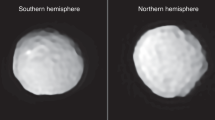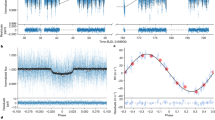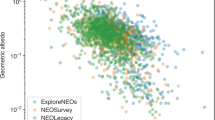Abstract
None of the approximately 750,000 known asteroids and comets in the Solar System is thought to have originated outside it, despite models of the formation of planetary systems suggesting that orbital migration of giant planets ejects a large fraction of the original planetesimals into interstellar space1. The high predicted number density2 of icy interstellar objects (2.4 × 10−4 per cubic astronomical unit) suggests that some should have been detected, yet hitherto none has been seen. Many decades of asteroid and comet characterization have yielded formation models that explain the mass distribution, chemical abundances and planetary configuration of the Solar System today, but there has been no way of telling whether the Solar System is typical of planetary systems. Here we report observations and analysis of the object 1I/2017 U1 (‘Oumuamua) that demonstrate its extrasolar trajectory, and that thus enable comparisons to be made between material from another planetary system and from our own. Our observations during the brief visit by the object to the inner Solar System reveal it to be asteroidal, with no hint of cometary activity despite an approach within 0.25 astronomical units of the Sun. Spectroscopic measurements show that the surface of the object is spectrally red, consistent with comets or organic-rich asteroids that reside within the Solar System. Light-curve observations indicate that the object has an extremely oblong shape, with a length about ten times its width, and a mean radius of about 102 metres assuming an albedo of 0.04. No known objects in the Solar System have such extreme dimensions. The presence of ‘Oumuamua in the Solar System suggests that previous estimates of the number density of interstellar objects, based on the assumption that all such objects were cometary, were pessimistically low. Planned upgrades to contemporary asteroid survey instruments and improved data processing techniques are likely to result in the detection of more interstellar objects in the coming years.
This is a preview of subscription content, access via your institution
Access options
Access Nature and 54 other Nature Portfolio journals
Get Nature+, our best-value online-access subscription
$29.99 / 30 days
cancel any time
Subscribe to this journal
Receive 51 print issues and online access
$199.00 per year
only $3.90 per issue
Buy this article
- Purchase on Springer Link
- Instant access to full article PDF
Prices may be subject to local taxes which are calculated during checkout




Similar content being viewed by others
References
Charnoz, S. & Morbidelli, A. Coupling dynamical and collisional evolution of small bodies: an application to the early ejection of planetesimals from the Jupiter–Saturn region. Icarus 166, 141–156 (2003)
Engelhardt, T. et al. An observational upper limit on the interstellar number density of asteroids and comets. Astron. J. 153, 133 (2017)
Williams, G. V. MPEC 2017–U181: COMET C/2017 U1 (PANSTARRS)http://www.minorplanetcenter.net/mpec/K17/K17UI1.html (2017)
Jeans, J. H. Problems of Cosmogony and Stellar Dynamics Ch. III, 35–43 (Cambridge Univ. Press, 1919)
Warner, B. D., Harris, A. W. & Pravec, P. The asteroid lightcurve database. Icarus 202, 134–146 (2009)
Baggaley, W. J. Advanced meteor orbit radar observations of interstellar meteoroids. J. Geophys. Res. 105, 10353–10361 (2000)
Holland, W. S. et al. Submillimetre images of dusty debris around nearby stars. Nature 392, 788–791 (1998)
Volk, K . & Malhotra, R. The curiously warped mean plane of the Kuiper Belt. Astron. J. 154, 62–77 (2017)
Batygin, K. & Brown, M. E. Evidence for a distant giant planet in the Solar System. Astron. J. 151, 22–33 (2016)
Francis, C. & Anderson, E. Calculation of the local standard of rest from 20 574 local stars in the New Hipparcos Reduction with known radial velocities. New Astron. 14, 615–629 (2009)
Meech, K. J. et al. Inner solar system material discovered in the Oort cloud. Sci. Adv. 2, e1600038 (2016)
Francis, P. J. The demographics of long-period comets. Astrophys. J. 635, 1348–1361 (2005)
Wainscoat, R. J. et al. The Pan-STARRS search for near Earth objects. IAU Symp. 318, 293–298 (2016)
Denneau, L. et al. The Pan-STARRS moving object processing system. Publ. Astron. Soc. Pacif. 125, 357–395 (2013)
Chambers, K. C. et al. The Pan-STARRS1 Surveys. Preprint at https://arxiv.org/abs/1612.05560 (2016)
Magnier, E. A. et al. Pan-STARRS photometric and astrometric calibration. Preprint at https://arxiv.org/abs/1612.05242 (2016)
Magnier, E. A. et al. Pan-STARRS pixel analysis: source detection and characterization. Preprint at https://arxiv.org/abs/1612.05244 (2016)
Magnier, E. A. & Cuillandre, J.-C. The Elixir system: data characterization and calibration at the Canada-France-Hawaii telescope. Publ. Astron. Soc. Pacif. 116, 449–464 (2004)
Appenzeller, I. et al. Successful commissioning of FORS1 — the first optical instrument on the VLT. Messenger (Los Angel.) 94, 1–6 (1998)
Bertin, E. & Arnouts, S. SExtractor: software for source extraction. Astron. Astrophys. Suppl. Ser. 117, 393–404 (1996)
Fukugita, M. et al. The Sloan Digital Sky Survey photometric system. Astron. J. 111, 1748–1756 (1996)
Stellingwerf, R. F. Period determination using phase dispersion minimization. Astrophys. J. 224, 953–960 (1978)
Detal, A. et al. Pole, albedo and shape of the minor planets 624 Hektor and 43 Ariadne: two tests for comparing four different pole determination methods. Astron. Astrophys. 281, 269–280 (1994)
Bowell, E. et al. in Asteroids II (eds Binzel, R. et al.) 549–556 (Univ. Arizona Press, 1989)
Mommert, M. et al. TNOs are cool: a survey of the trans-Neptunian region. V. Physical characterization of 18 Plutinos using Herschel-PACS observations. Astron. Astrophys. 541, A93 (2012)
Trujillo, I., Aguerri, J. A. L., Cepa, J. & Gutiérrez, C. M. The effects of seeing on Sérsic profiles – II. The Moffat PSF. Mon. Not. R. Astron. Soc. 328, 977–985 (2001)
Fulle, M., and 40 colleagues. Density and charge of pristine fluffy particles from comet 67P/Churyumov–Gerasimenko. Astrophys. J. 802, L12 (2015)
Meech, K. J., Jewitt, D. & Ricker, G. R. Early photometry of comet p/Halley — development of the coma. Icarus 66, 561–574 (1986)
Christensen, E . et al. The Catalina Sky Survey: current and future work. In AAS/DPS Meeting Abstracts Vol. 44, 210.13 (AAS, 2012)
Dohnanyi, J. S. Collisional model of asteroids and their debris. J. Geophys. Res. 74, 2531–2554 (1969)
Jedicke, R., Larsen, J. & Spahr, T. in Asteroids III (eds Bottke, W. F. Jr et al.) 71–87 (Univ. Arizona Press, 2002)
Acknowledgements
Pan-STARRS1 is supported by NASA under grant NNX14AM74G issued through the SSO Near Earth Object Observations Program. K.J.M., J.T.K. and J.V.K. acknowledge support through NSF awards AST1413736 and AST1617015. This work is based in part on observations collected at the European Organisation for Astronomical Research in the Southern Hemisphere under ESO programme 2100.C-5008(A), and in part on observations obtained under programme GS-2017B-DD-7 at the Gemini Observatory, which is operated by AURA under cooperative agreement with the NSF on behalf of the Gemini partnership: NSF (USA), NRC (Canada), CONICYT (Chile), MINCYT (Argentina) and MCT (Brazil). This work is based on observations obtained with MegaPrime/MegaCam, a joint project of CFHT and CEA/DAPNIA, at the Canada–France–Hawaii Telescope (CFHT), which is operated by the National Research Council (NRC) of Canada, the Institut National des Sciences de l’Univers of the Centre National de la Recherche Scientifique of France, and the University of Hawaii. The data presented herein were obtained at the W. M. Keck Observatory, which is operated as a scientific partnership between California Institute of Technology, the University of California and the National Aeronautics and Space Administration. This observatory was made possible by financial support from the W. M. Keck Foundation. UKIRT is owned by the University of Hawaii (UH) and operated by the UH Institute for Astronomy; operations are enabled through the cooperation of the East Asian Observatory. We thank all of the directors who evaluated the requests for telescope time and facilitated the execution of the programmes on the telescopes: L. Ferrarese (Gemini), R. Ivison (ESO), D. Simons (CFHT) and R. McLaren (UKIRT). We also thank the queue operators and support staff who made the data available. We thank K. Withington for processing the CFHT data, S. Isani for help with non-sidereal guiding, and W. Varricatt and M. Irwin for help with WFCAM non-sidereal scheduling. We thank K. Kimura (Director of the ‘Imiloa Astronomy Center) and L. Kimura (a Hawaiian linguistics expert) for their suggestion of a name. We recognize and acknowledge the very significant cultural role and reverence that the summit of Maunakea has always had within the indigenous Hawaiian community. We are most fortunate to have the opportunity to conduct observations from this mountain.
Author information
Authors and Affiliations
Contributions
K.J.M. led the team post-discovery, including securing the telescope time for characterization and preparing for observing, contributed to data reduction and performed the sublimation modelling. R.W. discovered 1I/2017 U1 in the Pan-STARRS data and, with M.M., realized that it had a hyperbolic orbit. J.T.K. performed all of the photometry, developed new pipeline software, and contributed to the shape interpretation and calculation of velocity relative to the local standard of rest. O.R.H. helped to secure the VLT time, prepared the VLT phase II programme, performed the initial data processing, and developed the rotational light-curve–colour solution and assessment of shape and its implications. R.J. calculated the spatial number density of ISOs. K.J.M., R.W., M.M., J.T.K., O.R.H. and R.J. contributed to the analysis of the data. M.M. performed all astrometry, contributed to observing preparation, integrated the orbit backwards to determine the asymptote and developed the optimum strategy for future astrometry. R.J.W. contributed to the discovery, obtained early CFHT observations that revealed the asteroidal nature, alerted K.J.M. to the need for mobilization and prepared the CFHT observing. K.C.C. contributed to the UKIRT photometry and the calculation of motion with respect to the local standard of rest. J.V.K. prepared the Gemini phase II programme and oversaw the observations. K.J.M., R.W., M.M., J.T.K., O.R.H., R.J., R.J.W., K.C.C., J.V.K. and L.D. contributed to writing the paper. A.P. helped with the CFHT mosaic reductions. T.B. helped with the Keck observations. E.M. led the team that developed the PS1 image processing system, contributed Keck telescope time, performed the observing and reduced the data. M.E.H. supports the daily downloads for moving objects. H.F., C.W. and M.E.H. support the image processing pipeline system that makes the Pan-STARRS data possible. E.S.-L. is part of the team that examines the daily data. S.C. writes and maintains software for extracting moving objects from the PS1 data.
Corresponding author
Ethics declarations
Competing interests
The authors declare no competing financial interests.
Additional information
Reviewer Information Nature thanks P. Chodas and A. Fitzsimmons for their contribution to the peer review of this work.
Publisher's note: Springer Nature remains neutral with regard to jurisdictional claims in published maps and institutional affiliations.
Extended data figures and tables
Source data
Rights and permissions
About this article
Cite this article
Meech, K., Weryk, R., Micheli, M. et al. A brief visit from a red and extremely elongated interstellar asteroid. Nature 552, 378–381 (2017). https://doi.org/10.1038/nature25020
Received:
Accepted:
Published:
Issue Date:
DOI: https://doi.org/10.1038/nature25020
This article is cited by
-
A compelling explanation for the enigmatic small object ‘Oumuamua
Nature (2023)
-
Acceleration of 1I/‘Oumuamua from radiolytically produced H2 in H2O ice
Nature (2023)
-
‘Oumuamua and meta-empirical confirmation
Foundations of Physics (2022)
-
AMBITION – comet nucleus cryogenic sample return
Experimental Astronomy (2022)
-
Compact pebbles and the evolution of volatiles in the interstellar comet 2I/Borisov
Nature Astronomy (2021)
Comments
By submitting a comment you agree to abide by our Terms and Community Guidelines. If you find something abusive or that does not comply with our terms or guidelines please flag it as inappropriate.



